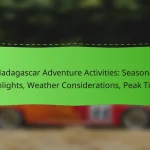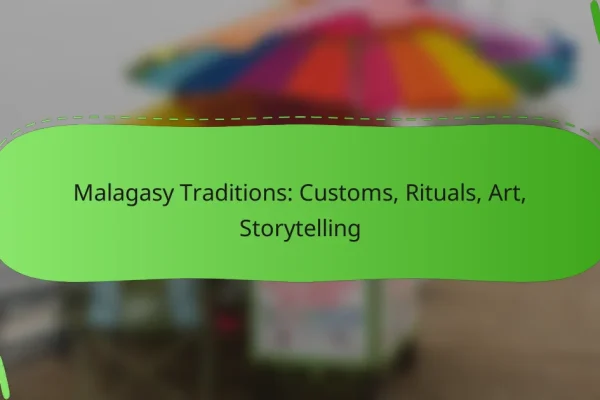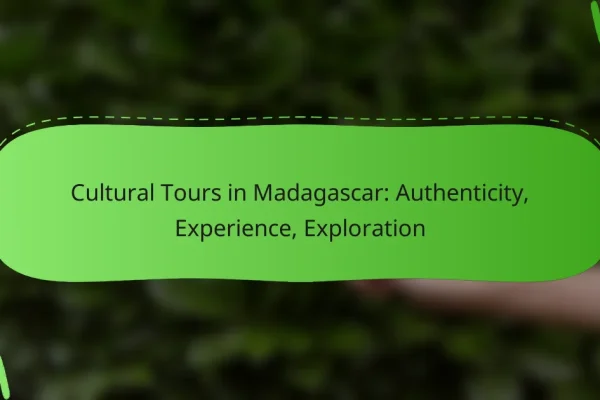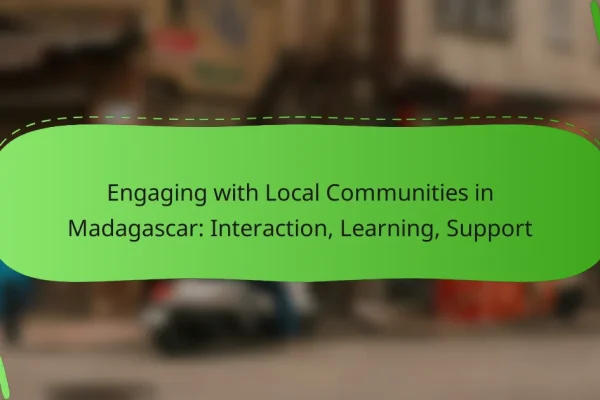What are the best cultural experiences in Madagascar?
The best cultural experiences in Madagascar include engaging with traditional music and dance, savoring local cuisine, exploring craft markets, staying in rural villages, and encountering unique wildlife. These activities provide rich insights into the island’s diverse heritage and natural beauty.
Traditional Malagasy music and dance
Traditional Malagasy music and dance are integral to the island’s cultural identity, often performed during celebrations and ceremonies. Styles vary by region, with instruments like the valiha (a bamboo tube zither) and the marovany (a box zither) commonly used.
Visitors can enjoy live performances at local festivals or cultural centers, where dancers showcase vibrant costumes and rhythmic movements. Participating in a dance workshop can also offer a hands-on experience of this lively art form.
Local cuisine tasting tours
Local cuisine tasting tours in Madagascar allow visitors to explore the island’s unique flavors, influenced by African, Asian, and European culinary traditions. Dishes such as romazava (a meat and vegetable stew) and ravitoto (pork with cassava leaves) are must-tries.
These tours often include visits to markets, where you can sample street food and learn about local ingredients. Joining a guided tour can enhance the experience, providing insights into cooking techniques and the cultural significance of various dishes.
Craft markets in Antananarivo
Antananarivo, the capital city, is home to vibrant craft markets where artisans sell handmade goods, including textiles, wood carvings, and jewelry. The Analakely Market is particularly popular for its wide variety of local crafts.
When visiting these markets, bargaining is common, so be prepared to negotiate prices. Supporting local artisans not only enriches your travel experience but also contributes to the community’s economy.
Village homestays in rural Madagascar
Village homestays offer an immersive experience in rural Madagascar, allowing visitors to live with local families and participate in daily activities. This can include farming, cooking, and traditional crafts, providing a deeper understanding of Malagasy life.
Choosing a homestay can enhance your cultural experience, as it fosters connections with locals and offers unique insights into their customs and traditions. Look for reputable homestay programs that prioritize community engagement and sustainability.
Wildlife encounters in national parks
Madagascar is renowned for its unique biodiversity, with many species found nowhere else on Earth. National parks like Andasibe-Mantadia and Ranomafana offer opportunities to see lemurs, chameleons, and diverse flora in their natural habitats.
Guided tours in these parks can enhance your wildlife encounters, as local guides share their knowledge about the ecosystem and conservation efforts. Be sure to respect wildlife and follow park regulations to ensure a safe and responsible experience.
How to plan a cultural trip to Madagascar?
Planning a cultural trip to Madagascar involves understanding the local customs, engaging with local experts, and timing your visit to align with cultural events. This approach ensures a richer experience and deeper appreciation of Madagascar’s unique heritage.
Research local customs and traditions
Understanding Madagascar’s diverse customs and traditions is crucial for a meaningful cultural experience. The country is home to various ethnic groups, each with distinct practices, beliefs, and celebrations. Familiarize yourself with local etiquette, such as greetings and dining customs, to show respect and enhance interactions.
Participating in traditional ceremonies, such as the Famadihana (the turning of the bones), can provide insights into the Malagasy way of life. Researching these customs beforehand will help you appreciate their significance and participate more fully.
Book guided tours with local experts
Engaging local guides can significantly enrich your cultural trip to Madagascar. Local experts offer valuable insights into the history, art, and traditions of their communities, which you might not discover on your own. Look for tours that focus on cultural immersion, such as village visits or artisan workshops.
When booking, consider small group tours or private guides to ensure a more personalized experience. This approach not only supports the local economy but also fosters meaningful connections with the people you meet.
Choose the best time to visit Madagascar
The timing of your visit to Madagascar can greatly impact your cultural experience. The dry season, from May to October, is generally the best time for travel, as it coincides with many cultural festivals and events. During this period, you can enjoy pleasant weather and participate in various local celebrations.
Be aware of the specific dates for major festivals, such as the Donia Music Festival in Nosy Be or the Hira Gasy performances in Antananarivo. Planning your trip around these events will allow you to witness the vibrant culture of Madagascar firsthand.
What are the unique cultural festivals in Madagascar?
Madagascar is home to several unique cultural festivals that reflect its rich heritage and traditions. These festivals often involve vibrant celebrations, music, and rituals that connect communities and honor ancestral customs.
Famadihana (Turning of the Bones)
Famadihana, or the Turning of the Bones, is a significant ritual celebrated by the Merina people in Madagascar. This event typically occurs every five to seven years, where families exhume the remains of their ancestors, rewrap them in fresh shrouds, and celebrate their memory with music, dance, and feasting.
During Famadihana, families gather to honor their ancestors, sharing stories and reminiscing about their lives. It is a time for strengthening family bonds and cultural identity, and it often attracts visitors who wish to witness this unique celebration.
Santabary Festival in Morondava
The Santabary Festival is a vibrant celebration held in Morondava, primarily to honor the rice harvest. This festival typically takes place in late December or early January and features traditional music, dance, and rituals aimed at giving thanks for the harvest.
During the Santabary Festival, locals engage in various activities, including rice planting demonstrations and culinary showcases. Visitors can enjoy local delicacies and participate in the festivities, experiencing the community’s deep connection to agriculture and culture.
Hira Gasy performances
Hira Gasy performances are a traditional form of entertainment in Madagascar, combining music, dance, and storytelling. These performances often take place during festivals and special occasions, showcasing the rich oral traditions and cultural narratives of the Malagasy people.
Typically featuring a mix of instruments such as the valiha (a bamboo tube zither) and traditional drums, Hira Gasy is both entertaining and educational. Audiences can expect lively performances that convey moral lessons, historical events, and social commentary, making it a unique cultural experience for both locals and tourists alike.
What are the key cultural sites to visit in Madagascar?
Madagascar is rich in cultural heritage, featuring numerous sites that reflect its unique history and traditions. Key cultural sites include the Rova of Antananarivo, the Avenue of the Baobabs, and Andasibe-Mantadia National Park, each offering distinct experiences that highlight the island’s diverse culture.
Rova of Antananarivo
The Rova of Antananarivo, also known as the Queen’s Palace, is a significant historical site located in the capital city. This royal complex was the residence of the Merina kings and queens, showcasing traditional Malagasy architecture and offering panoramic views of the city.
Visitors should consider taking a guided tour to fully appreciate the history and significance of the site. The Rova is currently undergoing restoration, so check for accessibility before planning your visit.
Avenue of the Baobabs
The Avenue of the Baobabs is one of Madagascar’s most iconic landscapes, featuring a striking row of ancient baobab trees. Located near Morondava, this site is particularly stunning at sunrise and sunset, making it a popular spot for photography.
When visiting, plan to arrive early or stay late to capture the best light. There are no entrance fees, but local guides can enhance your experience by sharing insights about the trees and their ecological significance.
Andasibe-Mantadia National Park
Andasibe-Mantadia National Park is renowned for its biodiversity and is home to several species of lemurs, including the famous indri. This park offers a unique opportunity to experience Madagascar’s rich wildlife in their natural habitat.
Visitors can explore various trails ranging from easy walks to more challenging hikes. It’s advisable to hire a local guide for the best wildlife spotting and to learn about the park’s conservation efforts. Entrance fees are typically around 45,000 MGA (Malagasy Ariary), so be prepared with local currency.
How to choose local guides for cultural experiences?
Choosing local guides for cultural experiences in Madagascar involves evaluating their expertise, reviews, and certifications. Prioritize guides who demonstrate strong cultural knowledge and language skills to enhance your understanding of local traditions and practices.
Check reviews and recommendations
Start by looking at online platforms where travelers share their experiences, such as TripAdvisor or Google Reviews. Pay attention to guides with consistently high ratings and positive feedback regarding their cultural insights and engagement with clients. Personal recommendations from friends or travel forums can also provide valuable insights.
Look for certified local guides
Certified local guides often have undergone training and adhere to industry standards, ensuring a certain level of professionalism and knowledge. In Madagascar, look for guides who are members of recognized associations, which can indicate their commitment to quality service and cultural education. Certification can also provide peace of mind regarding safety and ethical practices.
Assess language proficiency and cultural knowledge
Effective communication is crucial for a meaningful cultural experience. Ensure that your guide is fluent in your preferred language, as this will facilitate better understanding of the local customs and history. Additionally, inquire about their background in Malagasy culture, including traditions, festivals, and local practices, to ensure they can provide in-depth insights during your tours.
What are the challenges of experiencing culture in Madagascar?
Experiencing culture in Madagascar presents several challenges, primarily due to language barriers, geographical diversity, and varying levels of access to cultural sites. These factors can hinder meaningful interactions with local communities and limit the depth of cultural understanding.
Language barriers with local communities
Language barriers are a significant challenge when engaging with Madagascar’s diverse communities. The official languages are Malagasy and French, but many local dialects exist, which can complicate communication. Visitors may find that English is not widely spoken, especially in rural areas.
To navigate these barriers, learning a few basic phrases in Malagasy can be beneficial. Simple greetings or expressions of gratitude can foster goodwill and open doors to deeper cultural exchanges. Consider using translation apps or hiring local guides who can bridge the language gap.
It’s advisable to approach conversations with patience and openness. Non-verbal communication, such as gestures and facial expressions, can also enhance understanding when words fail. Engaging with local communities respectfully will enrich your cultural experience in Madagascar.












